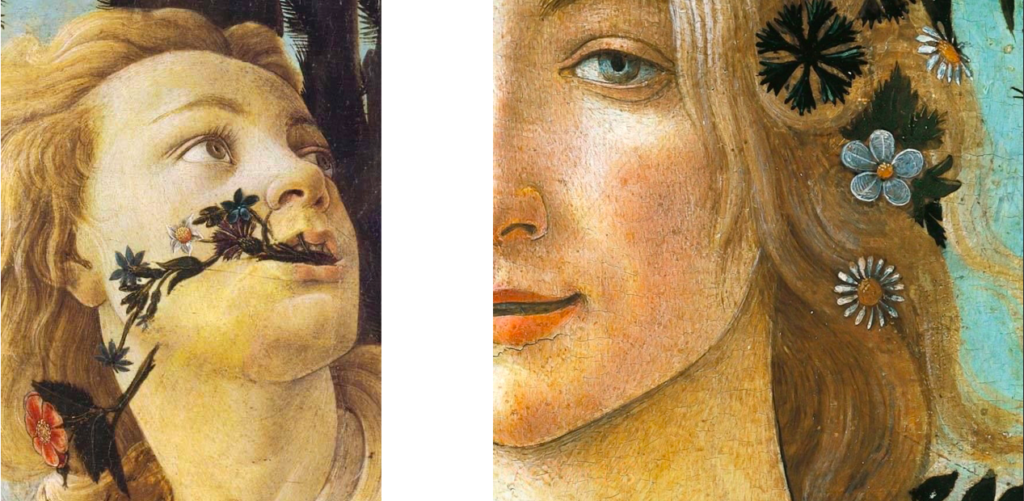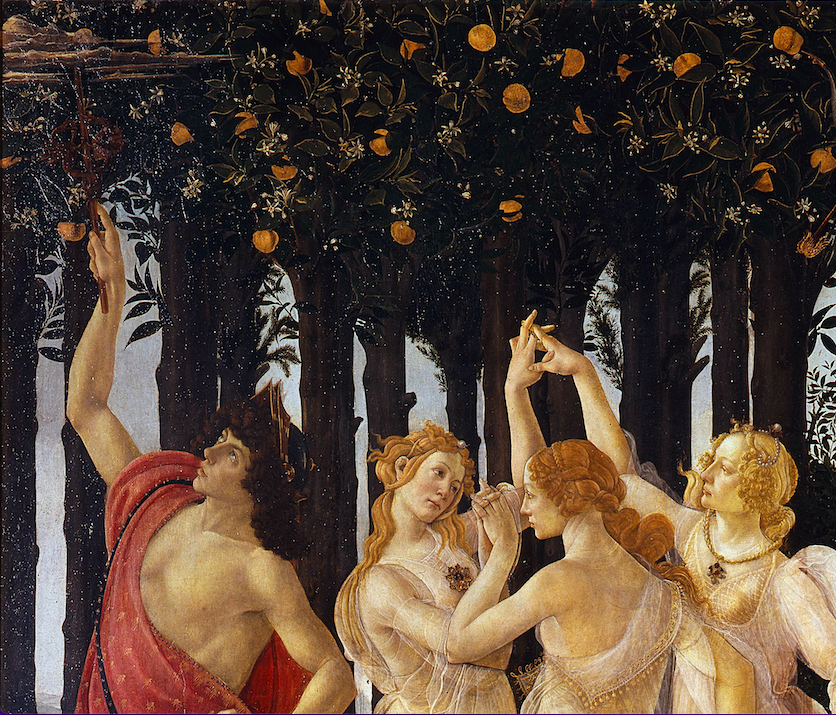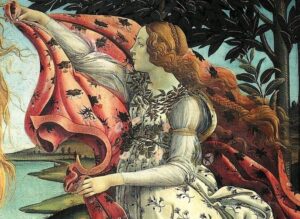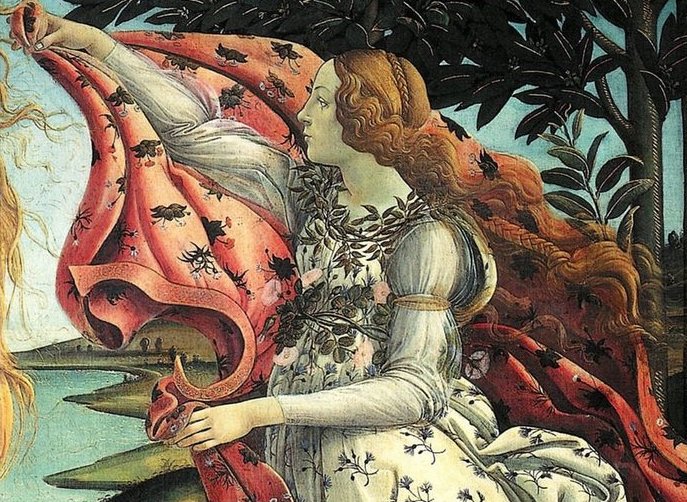
VENUS UNVEILED: The Venusian archetype in Astrology
VENUS DIGNITY
DOMICILE: Libra (primary) – Taurus (secondary)
EXALTATION: Cancer
TRANSPARENT EXALTATION: Pisces
FALL: Capricorn
EXILE: Aries (primary) – Scorpio (secondary)
VENUS: DESIRE – PLEASURE – LOVE
Just as MARS is the direct prehensile arm of the Sun, the one who translates the will of the Sun into action, so VENUS is the left arm of the Moon, the one who inwardly pulsates desire.
Desire (in italian Desiderare) has the Latin etymology de-siderare, which indicates the practice of sailors who turned to the stars to orient themselves in the immense dark seas of nights, for longitude.
The prefix de indicates origin, but also lack.
And from the stars sailors of life receive orientation, influence, direction.
So de-sire means to be devoid of stars and looking for their light and clarity.
Being without direction, the desire is vague, passive, often does not give in to action (Venus is yin, is passive).
MARS IS ORIENTATION: Mars is a vector, it is an arrow, it has a direction, that’s why it can attack.
If I want something and I don’t go to get it, the PRINCIPLE OF ATTRACTION develops from this open desidere. It is from desires that will can be (or not be) activated.
That’s why we can say that VENUS ACTIVATES / DEACTIVATES MARS.
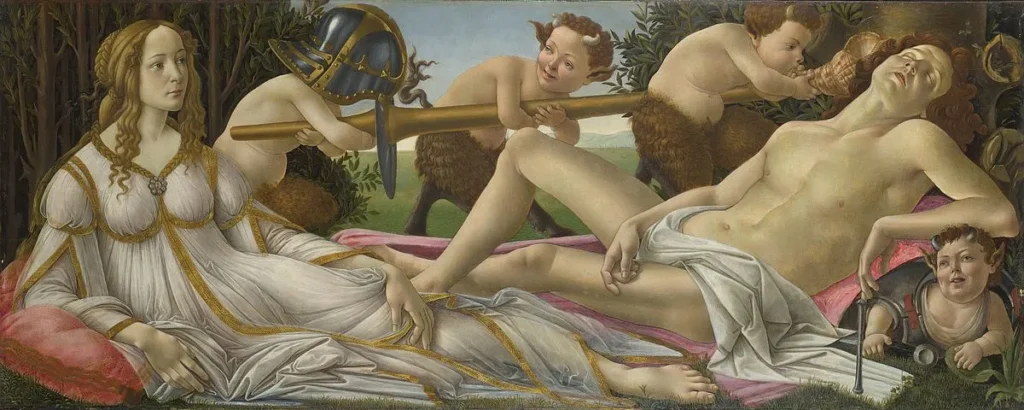
In the painting Venus and Mars, by Sandro Botticelli, we can see Venus motionless in her gentle and graceful pose, dressed in a noble long robe. Venus appears to be observing the scene and the figure of Mars carefully, she is straight, comfortable on her pillows, and well placed. On the other hand, instead, Mars, its opposite, usually well dressed even in cuirass and armour, lies helpless naked, with its head bowed (just like Venus in the painting of Spring — see the explanation below) and appears in the throes of sleep, ecstasy to some psychotropic substance (see in fact the fruit in the hands of the little faun below him), or in the release phase that follows the orgasm.
Mars is so exiled from himself that the little fauns play with his weapons and a faun plays the shell (usually used as a call for battle) in his ear, without him even realizing it.
He is completely absorbed, absent, taken by the attraction of Venus. We can almost say that in this painting the presence and attitude of Venus is Martian and the attitude of Mars is Venusian.
But the direction and verse of the spear really seem to indicate the radiation movement of the attraction from Venus towards Mars, like an arrow launched by Venus — however launched in full yin energy, or in immobility, because Venus does not need to move, unlike Mars, but only to stay, in order to express herself and her power.
There is another interesting detail, and it is the small fruit under the hand of the faun at the bottom right: that small fruit is a famous psychotropic fruit, maybe the Jimsonweed (in Italian “Stramonio”), a plant known for its aphrodisiac and hallucinogenic power, commonly also defined as “witches’ herb”, because it was used in European pagan rituals, of Indian tantric origin.
Psychological effects of Stramonio include confusion, euphoria, and delirium.
Botticelli as a Renaissance man, zodiac sign Pisces, certainly had knowledge of plants, of their symbolism and their use for divination.
Then with time the small details are slowly forgotten through the loss of consciousness and knowledge. And only those who still know how to “see” still know how to understand.
EXAMPLE: VENUS IN EXILE > ARIES
If the will comes first (like in Aries), the person immediatly take something (anything) with an instinctive action, but then he look better at it (or also after a little time) throw it away – just like the small baby makes with objects around him. The baby wants it and take it with a strong will and instinct, but then he realizes it wasn’t exactly what he wanted and he suddenly leave them, looking for the next thing.
VENUS AS PRINCIPLE OF ATTRACTION CHARM / BEAUTY
Venus is a principle of attraction, and it causes pleasure because it soothes the actions and the impulse.
In Astrology Reading we can add that the principle of attraction expresses itself corresponding to the House inside the Birth Chart where the planet Venus is.
YOU ARE FASCINATING, ATTRACTIVE AND SELF-CONFIDENT ESPECIALLY IN THE HOUSE WHERE YOUR VENUS IS INSIDE YOUR BIRTH CHART.
Where you have your Venus, there you will find your well-being, there you will feel really good and confortable doing something.
That’s why I say that you can express your Venusian energy at its best in the house where the planet is.
Venus expresses in which way you want to unite with someone (the aspect of Venus connected with Libra), so will be a person who has the characteristics of that House.
Furthermore Venus gives an indication of what type of food do you like more (the aspect of Venus connected with Taurus).
Example: Venus in the 6th House > I feel good working, I feel good at service, I want to do a job that I like (desire of Venus), I like to stay with people who are good workers, stable and practical.
VENUS IN LIBRA (DOMICILE)
A Venus in Libra is quite rational so she thinks a lot about the question:
“what really attracts me?”
Venus in Libra likes something non-corporeal, but sublime (please remember that the planet Neptune has its transparent exaltation in Libra).
Venus in Libra needs beautiful atmospheres and delicacy of the gesture.
But then in Libra Venus meets Saturn and Saturn brings also the other (choice) and the other brings the doubt, a doubt inside the same act of desire:
“Perhaps it was better if I had made that other choice!”
“It is better this man or the other one?”
And this process can really go on for a long time if the person is not aware of the personality game.
For a Venus in Libra, the substance is not important as much as the shape, she needs to feel good, to be satisfied inside:
It’s not enough for Venus in Libra to take the ice cream and eat if I feel hungry, but the full tea ceremony is needed!
Aesthetic beauty generates finally the deep principle of attraction, that in Libra is very strong.
VENUS IN TAURUS (DOMICILE)
Venus in Taurs is the Venus that likes pleasure, physical pelasure, and that likes to eat (hopefully fresh, healthy and natural food).
“It’s so good that I eat it”
In Taurus Venus meets Jupiter, so we have a person who loves to eat. In fact Jupiter archetype represents the mouth, and so we have a Venus who loves to open her mouth (and her legs if she feels pleasure, why not?), and she open to physical pleasures in a natural, beautiful and spontaneous way, like a flower spreading its parfumes for attracting the bees.
Taurus does not likes darkness as Scorpio, and Venus in Taurus is healthy, fertile, fruitful and loves to feed herself and others, without second or hidden motives nor manipulation, simply for sharing abundance and pleasure.
VENUS IN PISCES (TRANSPARENT EXALTATION)
“I get lost in love”
With Venus in Pisces, love has no compass, it has no direction anymore.
Venus in Pisces can make you lost in the sea of ideal love, so the effort is to try to recover the Venus which is lost somewhere into the Infinite, out of Space and Time.
“I am lost in him, I am lost of her, it drives me crazy!”
Venus in Pisces is without patterns, without rigidity, it is not hidden, but is exposed naked, like Botticelli’s Venus in the painting “The Birth of Venus”.
Venus in Pisces responds to Neptune (domicile in Pisces) and espress her excess of dependence.
“In loving I lose myself, I give myself completely, I release myself completely”.
And in this position the lost Venus waits then for her Jupiter (domicile in Pisces), the great Savior who only can save her from perdition.
Pisces gives everything completely, because Pisces expresses the communion with the Infinite, so a Venus in Pisces espresses the need to learn to love something bigger than herself (Jupiter, the expansion), and not only a simple person… because a person it’s not enough!
VENUS IN CANCER (EXALTATION)
“I need to be loved”
Cancer has the Sun as purpose (the Transparent Domicile of Sun is Cancer), so Cancer looks for someone who gives him attention, and Cancer’s final goal is just love, to be loved.
Venus in exaltation is in excess, so the person wants a lot of bonds, needs a lot of emotions. Venus in Cancer desires to bond, and it’s the feeling that moves Venus in this case, because in Cancer it’s the Moon that commands. Furthermore this feeling it’s continuous (not a short term one), because the Moon is the memory, and it repeats the feeling on and on, making it last.
It’s a compulsive kind of pleasure: you’re really in love and you can’t do without it, but with Venus in Cancer there is no dependence or perdition as in Pisces, since in Cancer there is the Sun in transparent domicile (identity, counsciousness of the self).
Venus in Cancer’s loving is subject to the Sun’s reasons, that’s why people with this Venus can be very touchy.
“If you haven’t looked at me I’m offended”
“Why haven’t you considered me?”
“Why didn’t he call me back?”
“Now I will lock myself in my room for all the day, because I’m taking it really personally”
“I love you so much and don’t you love me back? Then I have to suffer! This is my cruel destiny!”
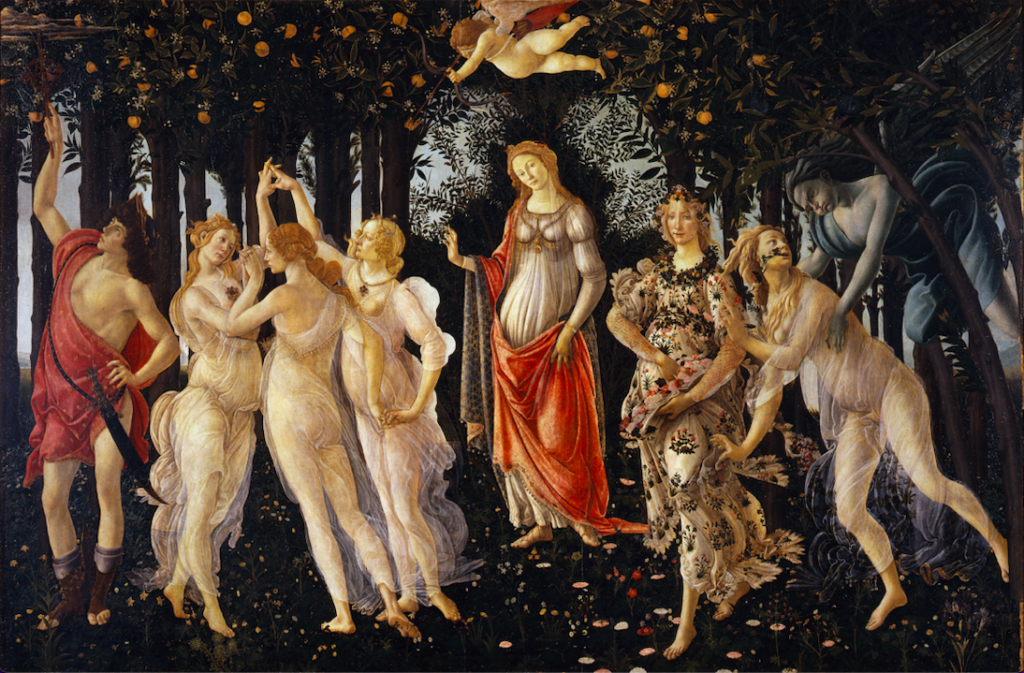
VENUS BY SANDRO BOTTICELLI: THE RENAISSANCE TEACHING
“LA PRIMAVERA” (SPRING) BY SANDRO BOTTICELLI
This painting is a condensed teaching from Renaissance Neoplatonic philosophy, expressing the study of philosophers Marsilio Ficino, Pico della Mirandola, and Angelo Poliziano.
Marsilio Ficino translated and commented on many texts by Plato, the ancient “Corpus Hermeticum” of the legendary Hermes Trismegistus and the works of Porphyry, Proclus and Plotinus, the greatest minds of Neoplatonism.
It is known that Marisilio Ficino recognized great importance to the persuasive force exercised through sight: nothing better than a picture, therefore, to make his teachings clearer.
For Neoplatonism, the function of figurative art, like music, is psychological: images can condition thoughts and actions of both people who create them (the artist) and of people who watch them.
This painting is a symbol of human consciousness towards self-realization, and at the same time the explanation of the evolution of the awareness of the Sacred Feminine towards the One.
CHARACTERS IN THE PAINTING:
Zephyr: The Life Energy
Cloris (the nymph) — Flora (the young goddess) — Venus (the mature goddess): the 3 Aspects of Venus
The 3 Graces: the 3 aspects of Love
Mercury: the Intellect
Cupid: the Passion
1. THE STADIUM OF THE NYMPH CLORIS
Zefiro — Zephyr (the fresh wind of Spring) arrives first, like a wind of desire with a greyish-blue color, which is the color of the shadow, the color of the lividus, the color of the alchemical transformation between black and white, which allows white not to be pure naivety; blue is the experience of evil that we have to meet, and that slowly transforms through sufference into presence and wisdom. Zephyr arrives from the shadows (= the unconscious) as a signal of the unconscious powers of life and creation, that overwhelm the young nymph CLORIS. Cloris is enveloped by the breath of Zephyr, which is something that a young woman still do not know, something completely new to her and which, at the beginning, creates confusion and bewilderment in front of this new youthful energies, possesing suddenly the body and changing its shapes. Cloris is not watching in towards the fronts, but she is moving back, with an unstable pose. Flowers starts to come out from the mouth of Flora, but she is not aware of her power yet, so she is frightened and she cannot control her feminine power yet.
2.THE STADIUM OF FLORA
The culmination of the unaware power of Life is Botticelli’s FLORA, who represents the power of natural vitality: the fullfillment of womanhood. Flora shows the full and mature femininity, fertile, abundant and nourishing, she looks directly on the front, and she is covered by flowers everywhere.
She now can control her feminine power of creation, in a conscious and mature way, and she is so abundant that she can even distribute flowers to others. Nonetheless, she still uses flowers to adorn her body, to appear, to make herself more precious and appetizing. She dresses up.
3. THE STADIUM OF VENUS – THE GODDESS
Venus is at the centre, and she is the background of the scene, observing all her aspects and shapes. Behind her the shape of the Circle, the symbol of Unity. Venus is the Observer. Like Flora, she is pregnant, but she is half covered with a long coat colored with the two colors blue and red, that now she can both dominate. She controls and holds the coat with right hand. Her head is not streight, but slightly inclined to the right, and her right hand is raised in the mudra that refears to overcoming all the fears, typical of paintings of Holy Mary.
Venus is now aware, aware that she is not the one who possess the vital energy, she is not the one who is creating life, while instead it is Life itself that is using her to express its infinite power. Venus has understood that I and mine are just illusions, and that emptiness is really fertile.
DYNAMISM OF VENUS
The profound meaning of the teaching of Botticelli’s Primavera is the aspectof dynamism, which is anti-ideological. As you can see in the painting, there is an ascendant line, starting from Cloris that is bent and still scared, to Flora who is spreading flowers into the world, and finally Venus who is the highest one, in her majestic passive posture. Botticelli express the Reniassance’s teachings that indicates to the woman not to stop even at this stage of Flora, but to go on with the evolution in order to reasearch for a deeper Knowledge behind the full process!
Botticelli in this painting clearly shows us his propensity for anti-ideological dynamism: we think we have arrived at the truth at each step, and we take the stamp of the truth achieved (it can be a magical, religious, philosophical truth of any kind), but the gesture that generates art and that generates life is a gesture that cannot be stopped or labeled or categorized, because as a gesture, it immediately slips into the past and disappears.
Ideology, on the other hand, tries to stop, to block, to reason in mental and conceptual schemes and as such is simply ridiculous, because Life is a sacred gesture of continuous renewal.
Divine cannot be understood with logical, mental and conceptual reasoning.
Therefore Botticelli’s Primavera teaches us anti-ideological dynamism: when the research-thought is transformed into static-ideological-thought (I am arrived, I understood), it immediately bounces back and prevents us from living in the present.
The awareness of Cloris is the awareness of the terror, of the fear of the young woman grappling for the first time with the powerful breath of the desiring vital charge, and it is in the unawareness of those who do not know they are already Flora (spontaneous and natural vitality ), and to already be the power of a femininity, which is expressed in the lightness of the great magical power of beauty, which is the aesthetic-formal expression of life itself.
BEYOND IDEOLOGY
Botticelli’s Primavera conquers an absolute form, beyond any idea and ideology. It expresses the obvious difference between Botticelli’s Flora and a feminine guided and controlled by ideology.
Botticelli’s Venus is devoid of thought, it is full of the Self, it has an overwhelming lightness.
If this candid power of the triumph of the feminine and the power of the natural that is immediately awakening is transformed into ideology, the passage from Flora to Goddess is automatically blocked.
OVERCOMING THE STADIUM OF FLORA
This passage is connected to the forces of the unconscious that push the vital, evolved, ready, prepared subject beyond Flora, which implies the loss of Flora.
Venus is no longer Flora, Venus, the goddess, is no longer immersed in an unconscious theme of beauty and power, but is conscious and aware of the beauty and power that she has conquered herself, in self-awareness.
This form of superior beauty is called by Plato in his work “Simposium”, (and then by the Renaissance philosphy) the CELESTIAL VENUS (VENUS URANIA), as opposed to the TERRESTRIAL VENUS (Venus Pandemia), representing the earthly love tied to mere lust. In the painting Flora represents the Venus Pandemia, and whoever stops only at this, cannot meet the true Goddess.
But it is also important to honor the Venus Pandemic, because whoever does not give water to the flowers then bounces back to the unawareness and instincts of Cloris’stage.
SQUARE AND OPPOSITION IN ASTROLOGY: THE WOUNDED VENUS
The wound of abandonment can lead Venus to a relegation from the stadium of Flora to the one Cloris, so that she will keep behaving like a young girl, she will not be able to create deep relationships in her life.
She will be scared of men, or she will be in competition with them (that is the same). In any case this wound can be a signal of the inability to pass from the stadium of Flora to the one of Venus.
Other times, it is just an abandonment or a love betrayal that, through the profound experience of pain, loneliness, anger and suffering, ignites the spark of conscience and can be the stimulus and lever for the passage to the stadium of Goddess.
THE 3 GRACES
The three Graces, mythological maidens born to instill joy in the hearts of gods and mortals, are daughters of the Sun god and of the goddess Meti called Oceanina Egle, or, according to other myths, even daughters of Aphrodite herself (goddess of love).
They are:
AGLAIA: the Ornament or the Splendor;
EUFROSINE: Joy or Happiness;
TALIA: Fullness or Prosperity.
In the Neoplatonic vision, the three Goddesses would be the three forms of Love:
Castitas (Chastity),
Voluptas (Lust),
Pulchritudo (Beauty).
The 3 Graces dance together in a circle in which they are all connected, hand in hand, to indicate the passage that develops from one attitude to another: desire is born from beauty, beauty is born from chastity and so on, in a circle lived unconsciously, which can last a lifetime.
According to Neoplatonic philosophy the attitude of Castitas is the one that can lead to knowledge.
Why doesn’t the Grace Castitas dance like the other two concentrated Graces, watching towards the centre, and she looks outside the circle?
Because if Castitas danced there wouldn’t be the Hegelian moment of the negative: Castitas in fact denies the spectacular, overwhelming effect, she denies the vital revival of the Goddess expressed through Cupid’s arrow. She denies so the conscious and directed mature love that generates again and again the unleashing of Voluptas.
With this deep gesture of negation, she can see something else: she can see the god MERCURY, the Alchemist, who is driving away the clouds of ignorance from the Garden of Knowledge, with his caduceus.
Amor starts from Pulchritudo and ends in Voluptas.
Marsilio Ficino, De Amore, II, 2
‘Circulus… prout in Deo incipit et allicit, pulchritudo: prout in mundum transiens ipsum rapit, amor·, prout in auctorem remeans ipsi suum opus coniungit, voluptas. Amor igitur in voluptatem a pulchritudine desinit. ’
{The circle… as begins in God at the beginning attracts, (this is) beauty: as it passes into the world it seizes itself, (this is) love…, as returning to the author it unites its own work, (this is) pleasure. Love therefore ends in pleasure from beauty.}
The converting power of Love, able to transform and bring evolution, is illustrated by the Grace at the center — who is Castitas. She is represented from behind, looking towards Voluptas. Her right hand is on the hand of Voluptas, as if to support herself, while her right hand is down in Pulchritudo’s one, from which she turns away. A curious effect, a slight change of perspective, is produced by imposing the action defined by Marisilio Ficino’s inscription: we can read the group of the 3 Graces as the Neoplatonic triad of procession, conversion and return.
Ficino explains that Love turns from Pulchritudo to Voluptas, and this happens because Love naturally turns from Vision towards Joy, since the natural human tendency is to seek Joy as supreme Good and and superior Gift brought to the intellect.
CUPID
What is the difference between Cupid and Zephyr?
Zephyr has within himself the shadow of the Plutonic unconscious, while Cupid does not. Cupid is the power of the original infantile innocence, and we can see in fact that Cupid covered his eyes and cannot see, so he is just following his inner inspiration and to the rational sense of sight.
Cupid is the clarity that the Goddess Venus, who is fully candid and pure, generates. Venus generates Cupid, that is fact in the painting is just over her in the centre, and forever they will be a duo: where there is Venus, there will be Cupid, too.
Venus generates Cupid because she is free from unconscious dark nuances, and she is totally clear; she no longer has those complacent undertones of Flora, who is still captured by the darkness inside her ego, so that Cupid can spawn the passage towards Voluptas.
The dance of the 3 Graces is not the goal of the alchemical, magical-esoteric journey.
The goal of the Renaissance path does not stop at the vital unleashing of Voluptas, which is the atomic connection of Pulchritudo that becomes Voluptas only through the negative passage of Castitas. It is the deep “NO” that Venus has to give to the repetition of the same experience. The abandoned Venus or the betrayed Venus is the woman who went through a deep pain, but in this way she understood that her Animus is herself, that she herself is the container of all aspects of life. Through this awareness she finds out that her elemental mind had been kidnapped by a superficial idiot external man and she finally let him go.
It is the self-power the difference between Venus and Flora.
Venus has a quantum alignment to power, and this generates the beauty and her deep magnetism. This magnetism is the magic of Venus, and then the male is immediatly attracted. It is overcoming the suffering of the wounded feminine that generates magnetism in the woman.
How many times has happened that a woman finally lets go the status of victim and dependace, and starts to feel strong again alone, and in that moment the man who left her, strangely feels a new attraction for her?
But beware of Voluptas, the lust! Here the woman risks a new circle that traps her in unawareness. If Voluptas gives in, and this often happens because the flesh is weak, then she regresses again to the stadium of the flesh, thus Venus is lost. The woman falls back into the old karmic game another time and she will suffer again.
Be aware: recovering to Flora’s vitality causes Venus to be lost.
Castitas is not sex phobia or abstinence. Castitas is the ability to know how to say a strong and peaceful “NO” to one’s desire that had already cheated you once! Here can emerge the empowerment of the woman, that can grow more and more.
Castitas points to the golden apples, points beyond Pulchritudo and beyond Voluptas, she leaves the Karmic Wheel (the Circle) that revolves around itself, and she points straight to Knowledge. This is the Knowlegde of the mind which lights up and of Mercury that is ready and catches it, this is a physical shot of understanding.
MERCURY, THE ALCHEMIST
Mercury is the Archetype of Intellect, and only throught Castitas, we can develop the desire for the knowledge for the Truth.
According to Neoplatonic philosophy the attitude of Castitas is the one that can lead to knowledge.
Why doesn’t the Grace Castitas dance like the other two concentrated Graces, watching towards the centre, and she looks outside the circle?
Because if Castitas danced there wouldn’t be the moment of the negative, that the philosopher Hegel will describe in future so well: Castitas in fact denies the spectacular, overwhelming effect; she denies and interrupt the vital revival of the Goddess expressed through Cupid’s arrow. And in this way, she denies also the conscious and directed mature love that generates again and again, in the unconscious wheel of karma, the unleashing of Voluptas.
With this deep gesture of negation, she can see something else, for the first time out of the karma: she can see the god MERCURY, the Alchemist, who is driving away the clouds of ignorance from the Garden of Knowledge, with his instrument, the caduceus.
From the point of view of the scene in the painting (that is called “The Spring”), Mercury is protecting this sacred garden and the season of spring from the arrival of storms and bad weather. In this sense he has also a little sword and a helmet, so he is a kind of guardian for the garden, dressed with the mantel of Medici family with little flames. The Medici family were the clients of the work (the word “Medici” in Italian means medicians), and the oranges, that we can find in abundance in this painting, were also their symbol.
From the point of view of philosophy, Mercury, with his winged sandals strongly connected with Earth and the sight towards the sky, is the Messanger that can finally unify Heaven and Earth, the true Neoplatonic Philospher and Alchimist. In this sense Mercury watches higher than anyone else, and only in this way he can remove the darkness from Humanity.
RHYTHMIC ASPECT OF BOTTICELLI’S PRIMAVERA
3 x 3 = 9 > completeness
FIRST TRIAD: Zephyr, Cloris and Flora
SECOND TRIAD: Venus, Cupid, Mercury
THIRD TRIAD: 3 Graces
The Mind of Marsilio Ficino, and of the entire Renaissance, which is the enlightened Mind of Upanisad, of Chinese Chan and of Japanese Zen, and of many other ancient philosophies, is an awake mind – that is, a mind that does not separate.
***
Botticelli’s masterpiece reproposes all this process of liberation and enlightement of the Feminine, and the process is just there on the pain, in front of us, all its parts together, so that we can see, and maybe our mind finally will do a sudden click and will bring us out of the karmic wheel once for all.
*******
THANK YOU FOR READING!
Giulia Miscioscia
VOICE OF PLENTY
Refelctions inspired by a lecture of Marco Pesatori, astrologist and historical of art.
